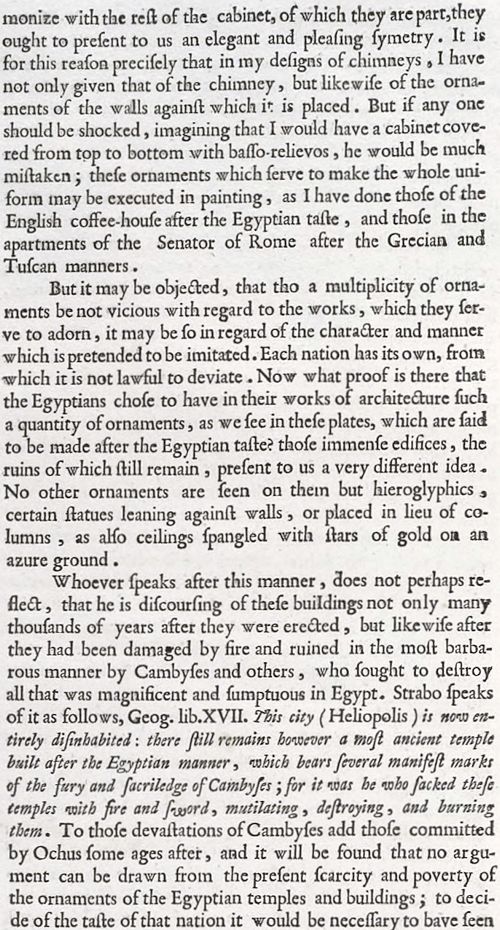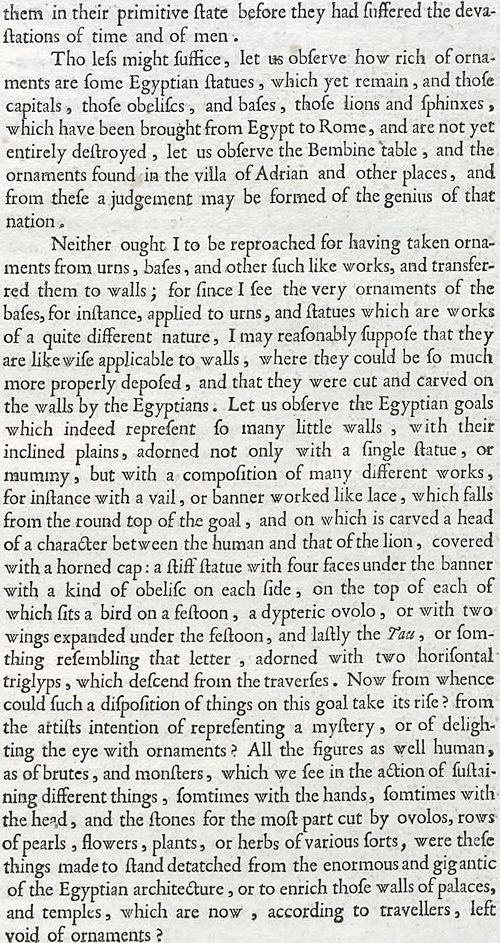
base, the jambs, the lintel and cornice, when they represent a door: or columns, or pilasters with their capitals sustaining an architrave, a freeze, a cornice, and pediment, if it be thought proper, when the chimneys represent the front of a portico. I cannot, I said, be of the opinion of such: they are mistaken, and do not see the impropriety of such an opinion. Either the height of the door is proportioned to the wideness, in which case the chimney would be monstrous and inconvenient, or if the width be made in proportion to the height, it would be too small, and would have the appearance of a furnace, rather than of a chimney; unless those people should fancy that chimneys ought to represent the doors of prisons, which are generally made lower and narrower than usual. But the idea of the portico is no less extravagant, and no less subject to the same inconveniencies: Befides some people in certain countries have their chimneys in the angles of their rooms, which places are not susceptible either of doors, or porticos, and it would be ridiculous to represent a door or a portico in the angle of a room; if it were necessary for chimneys to resemble any thing, I should think they ought rather to be made in resemblance of a cup board, or chest of drawers, than of a door or front of a portico. But neither does this idea, to say the truth, satisfy me, for I am rather inclined to think that chimneys form a particular
class in architecture by themselves, which class has its own particular laws, and proprieties, and is susceptible of all the embellishments, and variety which the small architecture can furnish, and of more than would be proper for a door, or the front of a portico: since Varro speaking of buildings and furniture in general says (ling.lat.lib.VIl.) that in them we not only seek to provide for our necessities, but also to find in them pleasure and enjoyment: Hence it is that in dress we not only seek, to be defended from cold, but also to make a decent appearance, and we will not only have houfes for our security and to cover us, but likewise to dwell in with pleasure: and we are not satisfied mith vases which are only fit for the use of our tables, but they must be of an elegant form and of exquifite workmanship, for there is a difference between what the necessities of man absolutely require and what is proper for a man of rank and education. I am of opinion that this may be applied particularly to the chimneys of our cabinets, they ought not only to serve to warm us; but likewise to please the eye by the elegance and variety of their ornaments; and as they are placed, I may say to harmonize
| |

with the rest of the cabinet, of which they are part, they ought to present to us an elegant and pleasing symmetry. It is for this reason precisely that in my designs of chimneys, I have not only given that of the chimney, but likewise of the ornaments of the walls against which it is placed. But if any one should be shocked, imagining that I would have a cabinet covered from top to bottom with basso-relievos, he would be much mistaken; these ornaments which serve to make the whole uniform may be executed in painting, as I have done those of the English coffee-house after the Egyptian taste, and those in the apartments of the Senator of Rome after the Grecian and Tuscan manners.
But it may be objected, that tho a multiplicity of ornaments be not vicious with regard to the works, which they serve to adorn, it may be so in regard of the character and manner which is pretended to be imitated. Each nation has its own, from which it is not lawful to deviate. Now what proof is there that the Egyptians chose to have in their works of architeaure such a quantity of ornaments, as we see in these plates, which are said to be made after the Egyptian taste? Those immense edifices, the ruins of which still remain, present to us a very different idea. No other ornaments are seen on them but hieroglyphics, certain statues leaning against walls, or placed in lieu of columns, as also ceilings spangled with stars of gold on an azure ground.
Whoever speaks after this manner, does not perhaps reflect, that he is discoursing of these buildings not only many thousands of years after they were erected, but likewise after they had been damaged by fire and ruined in the most barbarous manner by Cambyses and others, who fought to destroy all that was magnificent and sumptuous in Egypt. Strabo speaks of it as follows, Geog. lib.XVII. This city (Heliopolis) is now entirely disinhabited: there still remains however a most ancient temple built after the Egyptian manner, which bears several manifest marks
of the fury and sacriledge of Cambyses; for it was he who sacked these temples with fire and sword, mutilating, destroying, and burning them. To those devaluations of Cambyses and those committed by Ochus some ages after, and it will be found that no argument can be drawn from the present scarcity and poverty of the ornaments of the Egyptian temples and buildings; to decide of the taste of that nation it would be necessary to have seen
| |

them in their primitive state before they had suffered the devastations of time and of men.
Tho less might suffice, let us observe how rich of ornaments are some Egyptian statues, which yet remain, and those capitals, those obelisks, and bases, those lions and sphinxes, which have been brought from Egypt to Rome, and are not yet entirely destroyed, let us observe the Bembine table, and the ornaments found in the villa of Adrian and other places, and from these a judgement may be formed of the genius of that nation.
Neither ought I to be reproached for having taken ornaments from urns, bases, and other such like works, and transferred them to walls; for since I see the very ornaments of the bases, for instance, applied to urns, and statues which are works of a quite different nature, I may reasonably suppose that they are like wise applicable to walls, where they could be so much more properly deposed, and that they were cut and carved on the walls by the Egyptians. Let us observe the Egyptian goals which indeed represent so many little walls, with their inclined planes, adorned not only with a single statue, or mummy, but with a composition of many different works, for instance with a vail, or banner worked like lace, which falls from the round top of the goal, and on which is carved a head of a character between the human and that of the lion, covered with a horned cap: a stiff statue with four faces under the banner with a kind of obelisk on each side, on the top of each of which fits a bird on a festoon, a dypteric ovolo, or with two wings expanded under the festoon, and lastly the Tau, or something resembling that letter, adorned with two horizontal triglyps, which descend from the traverses. Now from whence could fuch a dispofition of things on this goal take its rise? From the artists intention of representing a mystery, or of delighting the eye with ornaments? All the figures as well human, as of brutes, and monsters, which we see in the action of sustaining different things, somtimes with the hands, somtimes with the head, and the stones for the most part cut by ovolos, rows of pearls, flowers, plants, or herbs of various sorts, were these things made to stand detached from the enormous and gigantic
of the Egyptian architecture, or to enrich those walls of palaces, and temples, which are now, according to travellers, left void of ornaments?
|